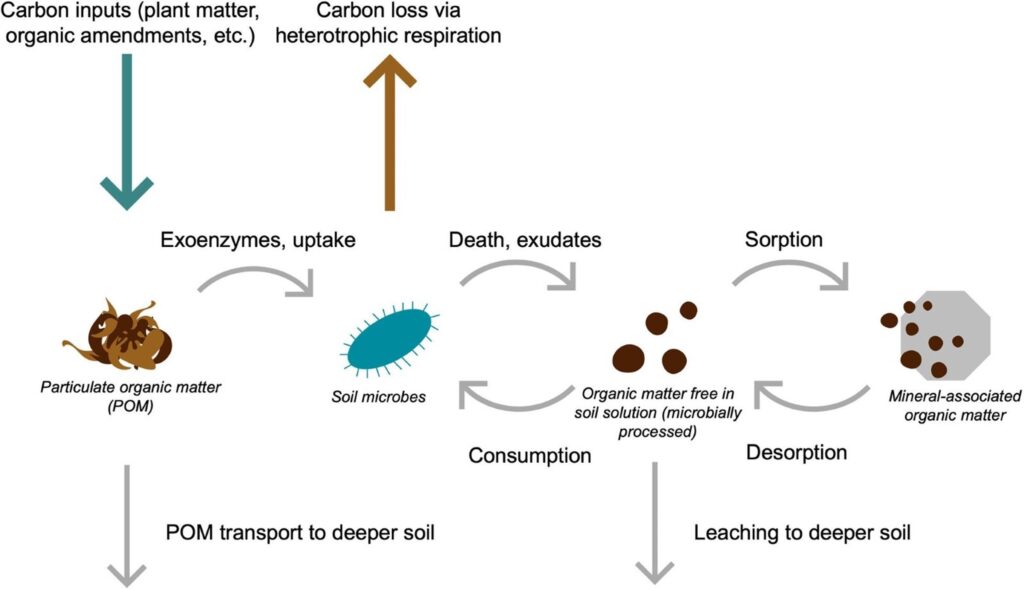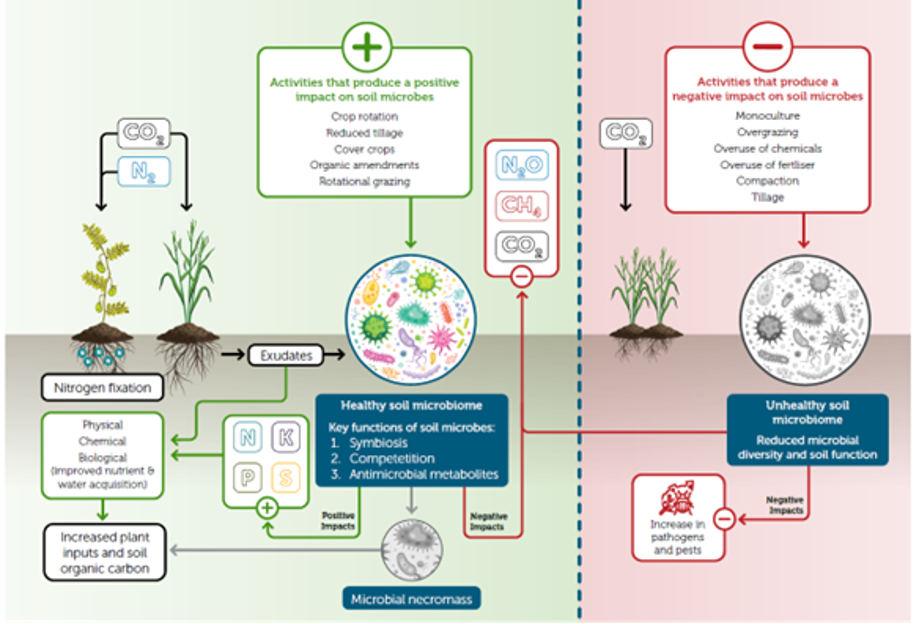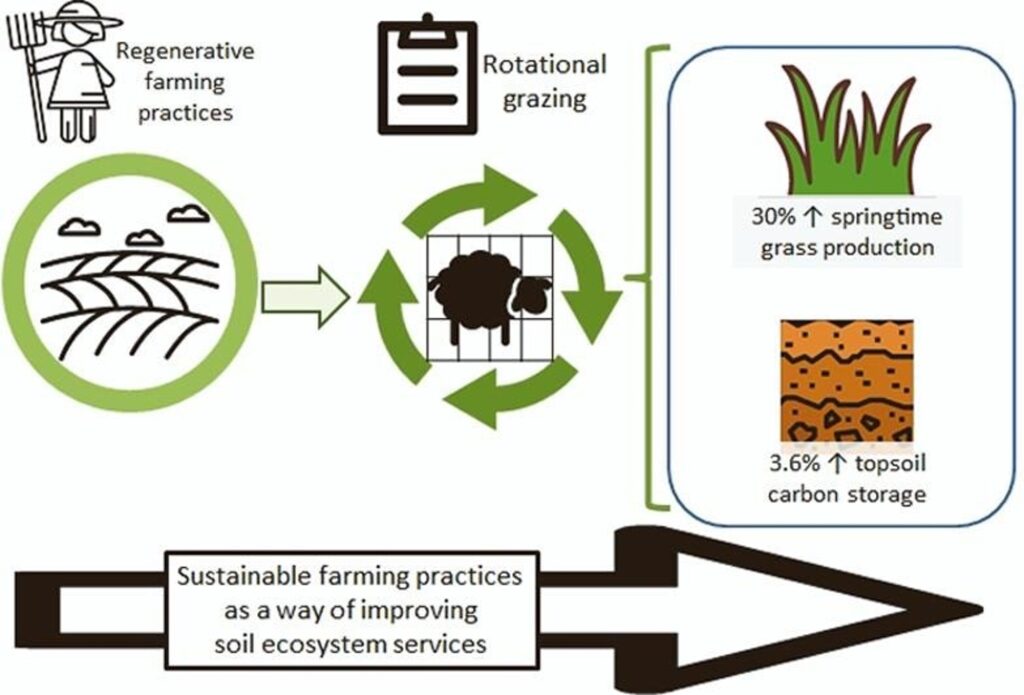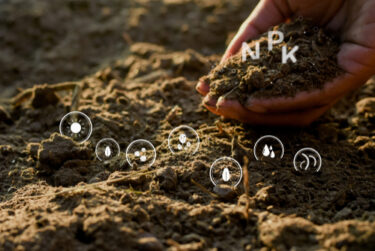30 November 2023
Revealing Their Leading Role In Climate Change Mitigation
by Dr. Siviwe Malongweni, Research Coordinator: Agriculture & Soil Carbon
The soil serves as a major carbon reservoir, holding more carbon than the earth’s vegetation and atmosphere combined. This pivotal role makes the soil an essential remedy for tackling the climate crisis. The soil does this with the help of the incalculable number of microorganisms that live within it. In agricultural lands, these tiny unsung heroes play a crucial role in soil carbon storage, an essential process for climate change mitigation. Microbes, including bacteria, fungi and archaea are responsible for breaking down organic matter, such as decaying animal waste and plant residues, via the process of decomposition. During decomposition microbes release carbon dioxide as a by product back into the atmosphere (See the brown arrow in Figure 1). However, the story does not end there. Although microorganisms release carbon dioxide, they also play a significant role in capturing and preserving soil carbon. A significant portion of the organic matter that microbes consume is partially converted into stable, long-lasting forms of carbon that can remain stored for decades, centuries, or even millenia.

Figure 1. Illustration showcasing the dynamics of soil carbon flow under the influence of microorganisms.
The capacity of soil to sequester carbon with the assistance of microorganisms, is significantly influenced by farming practices. Adopting sustainable farming methods, such as minimizing mechanical soil disturbance, maintaining a permanent soil cover using living and dead plant material, practicing crop rotation, and implementing regenerative rotational grazing management, has a positive effect on microbial activity and carbon sequestration in the soil. these practices foster soil health, enhance organic matter inputs, and create a vibrant and diverse environment for soil microorganisms. As a result, the soil becomes a potent carbon sink, contributing to both environmental sustainability and agricultural productivity (Figure 2).

Figure 2. Soil, microorganisms, and farming practices interactive effect on soil organic carbon (Source: Regenerative Agriculture – A Literature Review on the Practices and Mechanisms Used to Improve Soil Health)
Scientific literature firmly establishes the significance of sustainable farming practices in promoting microbial activity, which plays a crucial role in soil carbon sequestration – a key aspect for agriculture and climate change mitigation. By harnessing the power of these tiny creatures, farmers and land managers can contribute to carbon sequestration efforts, mitigating the effects of climate change and building more resilient agricultural systems. For instance, according to a recent study published in Ecological Indicators, sustainable farming practices such as regenerative rotational grazing result in remarkable increase in grass production and a notable enhancement in topsoil carbon storage when compared to conventional rotational grazing (Figure 2). This is because regenerative grazing stimulates microbial activity and creates a more dynamic environment for soil microorganisms. This increased activity results in improved nutrient cycling and organic matter decomposition. Therefore, by improving microbial population and diversity, this land management approach fosters a sustainable and regenerative ecosystem that benefits both agricultural productivity and climate change mitigation.

Figure 3. Impact of regenerative rotational grazing management of dairy sheep on springtime grass production and topsoil carbon storage. (Source: Regenerative rotational grazing management of diary sheep increases springtime grass production and topsoil carbon storage)
The VM0042 methodology from Verra’s Verified Carbon Standard (VCS) aims to reward farmers through carbon credit revenue for improved agricultural land management that deliver sustainability and positive environmental impacts. However, the methodology focuses exclusively on chemical properties to quantify soil carbon sequestration and does not comprehensively assess microorganisms’ contribution to carbon cycling in agricultural lands. To further enhance the methodology’s accuracy and relevance, CNG aims to support future updates in considering the incorporation microbial activity, taking into account the latest research findings and addressing challenges related to data collection and practical implementation.
Undoubtedly, microbes emerge as champions in preserving our planet, and their commendable efforts deserve recognition. By nurturing these hidden heroes, farmers will pave the way towards a more sustainable and resilient future for agriculture and the planet we call home.
References:
Bio-agricultural company introduces the first-ever mycorrhizal carbon credits programme “Carbon Pulse” (2023) Carbon Pulse. (Accessed: 2 November 2023).
Díaz de Otálora X, Epelde L, Arranz J, Garbisu C, Ruiz R and Mandaluniz N (2021) Regenerative rotational grazing management of dairy sheep increases springtime grass production and topsoil carbon storage. Ecological Indicators 125: 107484.
Dynarski KA, Bossio DA and Scow KM (2020) Dynamic Stability of Soil Carbon: Reassessing the “Permanence” of Soil Carbon Sequestration. Frontiers in Environmental Science 8: 514701.
Hawkins H-J, Cargill RIM, Van Nuland ME, Hagen SC, Field KJ, Sheldrake M, Soudzilovskaia NA, Kiers ET (2023) Mycorrhizal mycelium as a global carbon pool. Current Biology, 33(11), R560-R573.
Khangura R, Ferris D, Wagg C and Bowyer J (2023) Regenerative Agriculture – A Literature Review on the Practices and Mechanisms Used to Improve Soil Health. Sustainability 15(3):2338.
